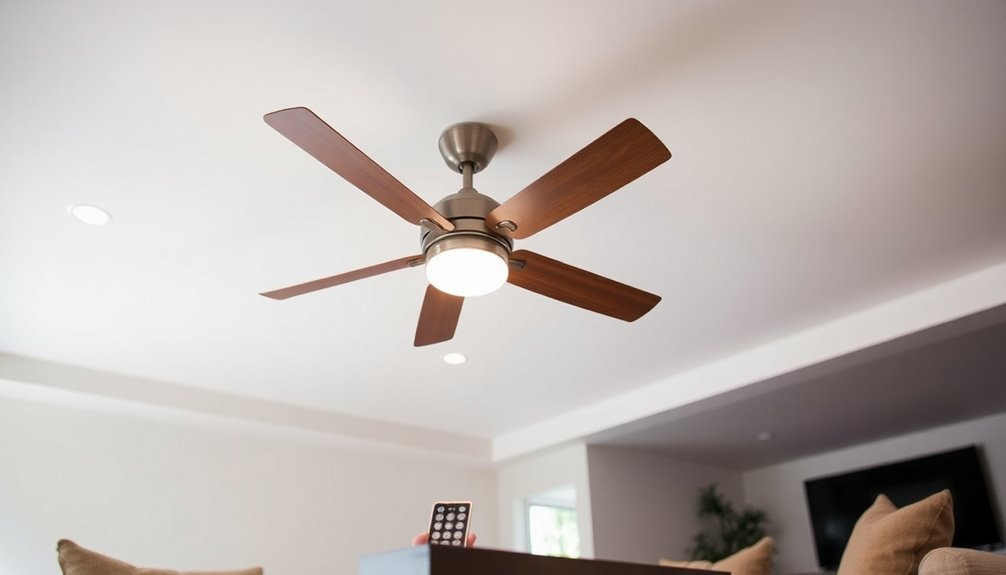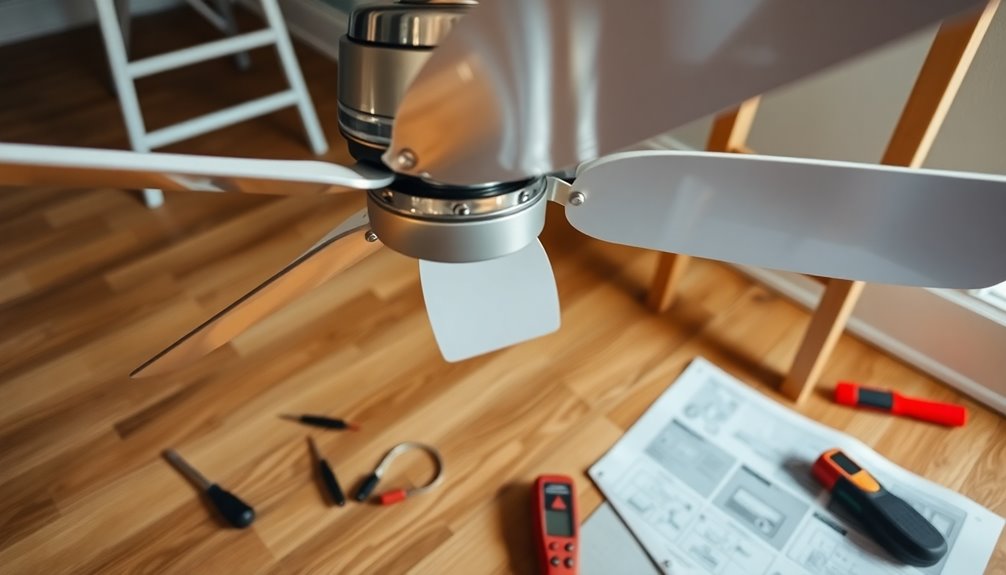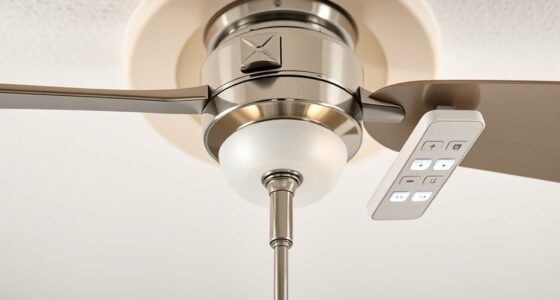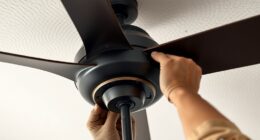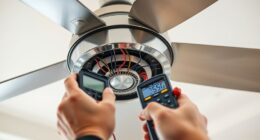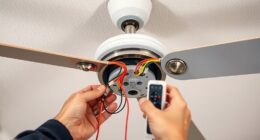A ceiling fan spins at speeds between 200 and 400 RPM, with effective models averaging around 300 to 365 RPM. For a standard 48-inch fan, you can expect speeds of 315 to 365 RPM, making it perfect for medium-sized rooms. The fan's blade size, pitch, and motor power influence these speeds. High-speed fans provide better air circulation, while larger, low-speed fans cover more area effectively. By understanding how these factors impact fan speed, you can enhance your comfort and energy efficiency in your space. Keep exploring to find out how to choose the right fan for your needs!
Key Takeaways
- Ceiling fans typically spin at speeds ranging from 200 to 400 RPM, with most effective models averaging between 300 to 365 RPM.
- Standard 48-inch ceiling fans usually operate at 315 to 365 RPM, ideal for medium-sized rooms.
- High-speed fans with larger motors can achieve higher RPMs for improved air circulation in small areas.
- Blade size, pitch, and thickness significantly influence a fan's speed and overall performance.
- Energy-efficient fans generally spin between 200 to 300 RPM, balancing airflow with reduced power consumption.
Understanding Ceiling Fan RPM
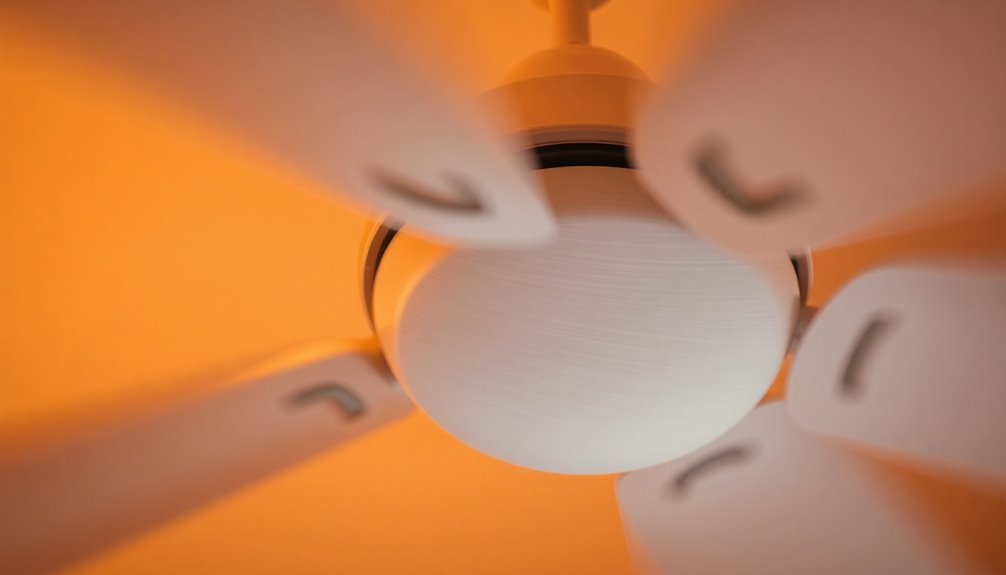
When it comes to ceiling fans, understanding RPM (revolutions per minute) is crucial for maximizing air circulation in your space. Most ceiling fans operate between 200 and 400 RPM, with effective models averaging around 300 to 365 RPM. For a standard 48-inch ceiling fan, you'll typically see RPMs ranging from 315 to 365, providing ideal airflow for medium-sized rooms.
The RPM of your ceiling fan directly impacts air movement and comfort. High-speed ceiling fans with larger motors can achieve higher RPMs, leading to increased air circulation and enhanced cooling effects.
However, it's important to take into account the influence of blade size and pitch, as these factors can greatly affect performance. Larger fan blades can move more air at a lower RPM, which can be more energy-efficient and reduce power consumption.
Regular maintenance, such as cleaning the fan blades and lubricating the motor, helps maintain ideal RPM and guarantees your fan operates effectively.
Factors Influencing Fan Speed
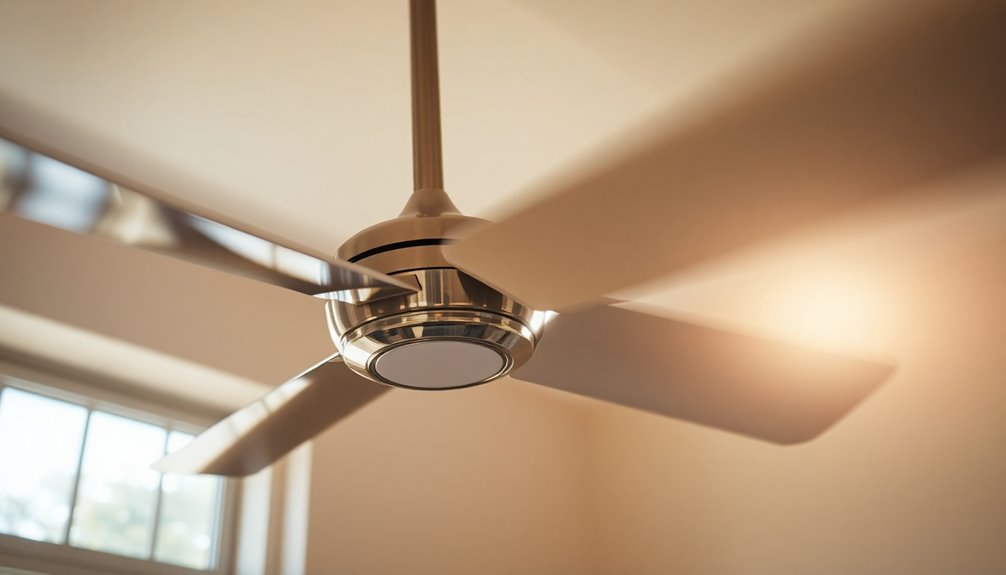
Ceiling fan speed is influenced by several key factors that determine how effectively it circulates air in your space. The speed, typically measured in revolutions per minute (RPM), usually ranges from 200 to 300 RPM for ideal air circulation.
One major factor is blade size; shorter blades tend to spin faster, while longer blades may slow down due to increased air resistance. The pitch of the blades also plays an essential role; higher pitch angles can lead to reduced fan speed.
Additionally, the number of blades affects fan speed. Fans with fewer blades can achieve higher speeds, as they experience less drag compared to those with more blades.
Motor size is another important element; larger motors generate more power, allowing for faster rotation. This increased power also impacts the fan's overall efficiency.
Finally, blade thickness can influence fan speed. Thicker blades require more power to spin, often resulting in slower speeds. In contrast, thinner blades enhance speed and improve overall air circulation.
High-Speed Vs Low-Speed Fans
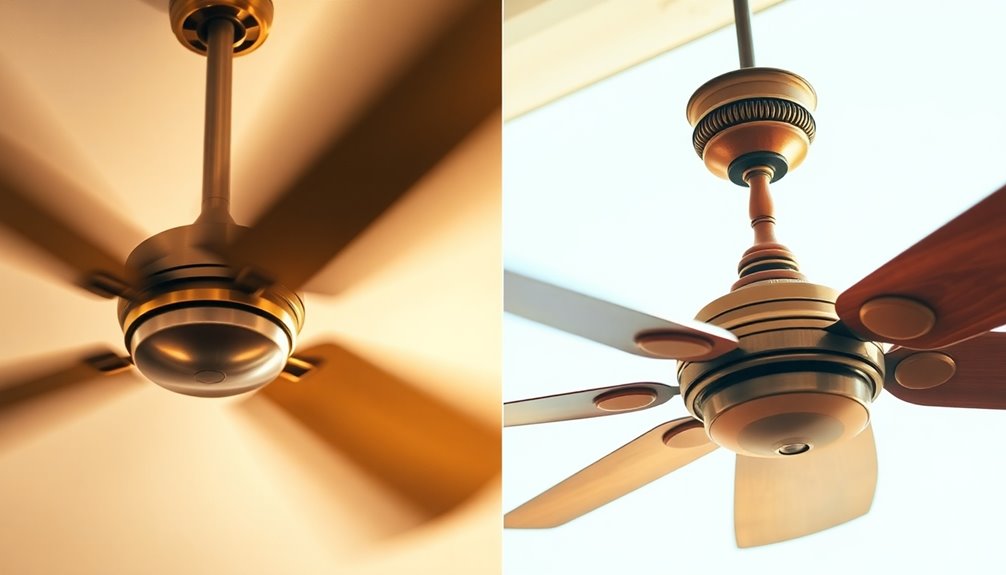
Fans come in various speeds to cater to different cooling needs, and understanding the difference between high-speed and low-speed models can make a significant impact on your comfort.
High-speed ceiling fans typically operate at RPMs ranging from 200 to 400, providing focused airflow ideal for small areas or individual use. These fans spin faster, delivering concentrated air circulation that can quickly cool you down when you need it most.
On the other hand, low-speed fans, including high-volume, low-speed (HVLS) models, operate at lower RPMs, typically between 40 and 200. While they may not spin as fast, they effectively circulate air over large spaces, making them suitable for areas up to 25,000 square feet.
Their design features larger airfoils, allowing for impressive air movement without needing high rotational speeds. Choosing between high-speed and low-speed fans depends on your specific airflow requirements. If you're looking for effective cooling in a small room, a high-speed fan is your best bet.
However, for larger spaces, a low-speed fan will provide the necessary air circulation to keep everyone comfortable. Additionally, some models incorporate advanced technology that enhances temperature regulation for improved comfort.
Impact of Speed on Air Delivery
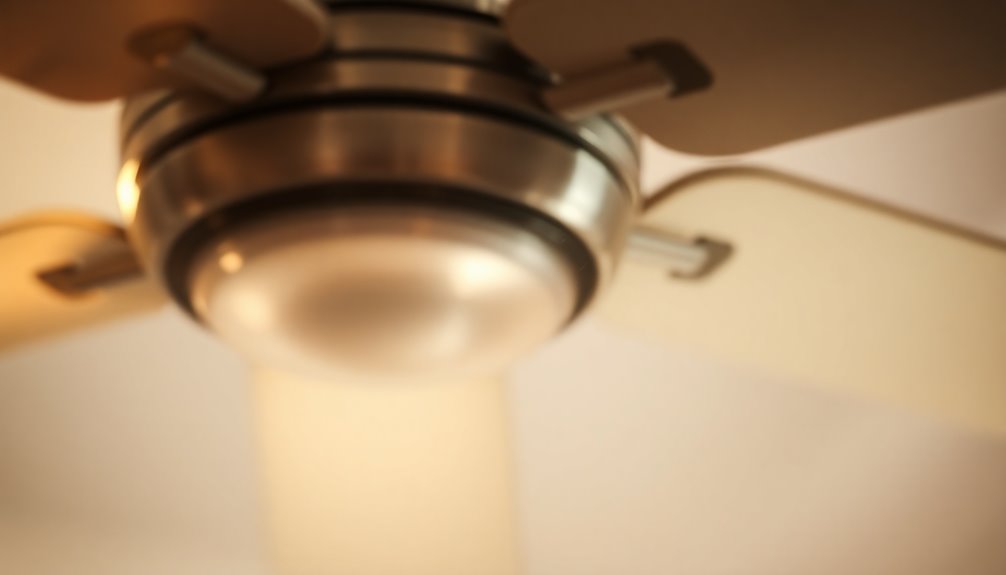
At varying speeds, ceiling fans remarkably influence air delivery and overall comfort in a room. Fan speed plays a vital role in determining how effectively air circulates. Typically, ceiling fans operate between 200 to 300 RPM, and higher RPM directly correlates with improved airflow and a greater cubic feet per minute (CFM) rating.
When you crank up the speed, you'll notice a significant cooling effect as the increased air movement lowers perceived temperatures, especially in stuffy spaces. Conversely, slower fan speeds can lead to stagnant air, diminishing comfort and indoor air quality. You might feel warmer and less invigorated if the air isn't circulating effectively.
That's why finding the best fan speed is essential; it enhances air delivery while still being mindful of energy consumption. Fans running at higher RPMs can be surprisingly efficient, delivering ample airflow without guzzling excessive power.
In essence, adjusting your ceiling fan's speed can drastically impact your comfort levels. By choosing the right speed, you can enjoy a cool, revitalizing environment while keeping energy costs in check.
Maintenance for Optimal Performance

Maintaining your ceiling fan is vital for guaranteeing ideal performance and longevity. Start by regularly cleaning the blades with a damp cloth or pillowcase to prevent dust buildup, which can impede airflow and reduce fan speed. A clean fan runs more efficiently, allowing it to maintain optimal performance.
Don't forget to lubricate the fan motor through oil ports or directly on the bearings. This simple maintenance task can enhance performance and keep your fan spinning smoothly.
Additionally, check for loose screws; tightening them can prevent wobbling and guarantee the fan operates at its intended RPM.
Inspect your ceiling fan for any damaged blades, as these can greatly affect its performance. If you notice any faults, consider replacing them to restore proper function.
Finally, keeping an eye on the electrical components is essential. Replacing faulty capacitors, often found in the fan hub, can improve the fan's speed and efficiency.
Energy Efficiency and Fan Speed
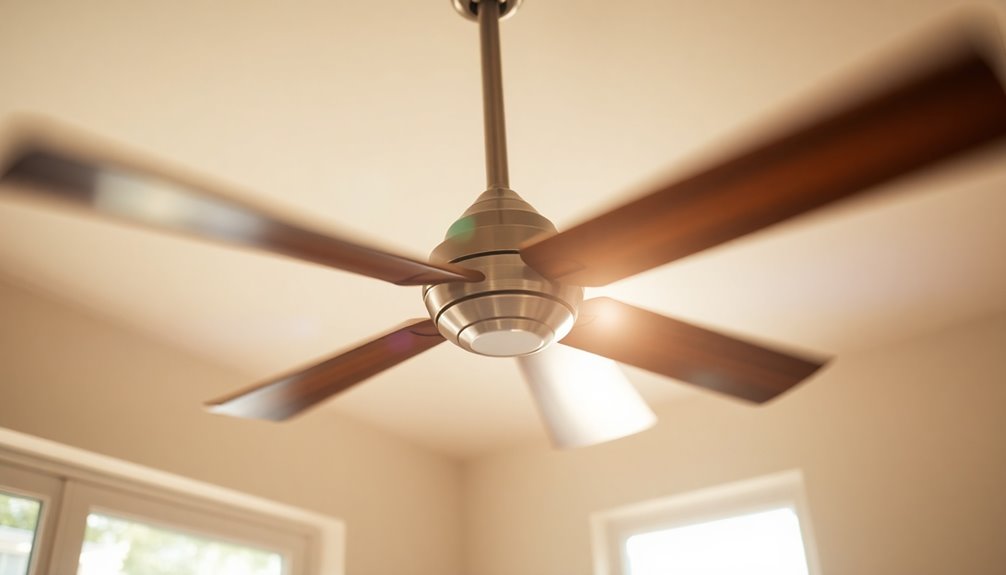
To maximize the benefits of your ceiling fan, understanding energy efficiency alongside fan speed is key. Ceiling fan speed typically ranges from 200 to 300 RPM, and choosing an energy-efficient model can make a notable difference. These models often use BLDC technology, which consumes less power while still providing ideal airflow delivery.
Higher RPMs can enhance cooling efficiency, but they might also increase energy consumption if the fan isn't designed for efficiency. The design of fan blades plays an important role here; wider blades can create drag, slowing speed and increasing power requirements. Additionally, many high-end fans feature energy-efficient motors that not only reduce consumption but also improve overall performance. Moreover, selecting models with HEPA filters can help improve indoor air quality while maximizing airflow. Regularly maintained fans can contribute to long-term energy savings by ensuring optimal performance and efficiency.
On the other hand, energy-efficient ceiling fans with advanced aerodynamic blades minimize turbulence, leading to better performance and lower energy bills. Regular maintenance, including checking the fan's motor health, is vital to ensure sustained energy efficiency and optimal fan speed over time.
To maintain energy efficiency and proper fan speed over time, regular maintenance is vital. Cleaning the blades and confirming the motor is in good health can greatly impact your fan's performance.
Frequently Asked Questions
How Fast Does a Ceiling Fan Spin in Mph?
To find out how fast a ceiling fan spins in miles per hour, you'll need to know its RPM and diameter.
Using the formula Speed = (RPM × π × Diameter) / 60, you can calculate the blade tip speed.
For instance, if your fan has a diameter of 4 feet and spins at 300 RPM, it'll reach about 31.42 mph.
What Is the Rotation Speed of a Ceiling Fan?
Isn't it ironic that something spinning above your head can be so hard to quantify?
The rotation speed of a ceiling fan typically ranges from 50 to 100 RPM for standard models. However, high-performance fans can reach speeds of 350 to 400 RPM.
Factors like blade size, pitch, and motor strength influence these speeds.
What Is the Average Velocity of a Ceiling Fan?
The average velocity of a ceiling fan's blades depends on several factors like blade size, pitch, and motor design.
Generally, when a standard 48-inch fan operates at around 300 RPM, the blade tip speed can reach approximately 41 miles per hour.
However, this speed varies with different fan models, as some might've a higher or lower RPM.
What Is the Average Wind Speed of a Ceiling Fan?
The average wind speed of a ceiling fan typically ranges from 10 to 15 miles per hour at the blade tip, depending on its design and speed setting.
If you're using a 48-inch model at full speed, you can expect a blade tip speed of around 41 miles per hour.
Factors like blade pitch and motor power can also affect airflow efficiency, so keep those in mind when choosing your fan.
Conclusion
In the whirlwind of comfort, the speed of your ceiling fan dances between a gentle breeze and a powerful gust. Remember, finding that sweet spot means balancing air delivery and energy efficiency. By keeping your fan well-maintained, you guarantee it spins at its best, creating a rejuvenating atmosphere in your space. So, let your ceiling fan twirl gracefully, turning your room into a haven of coolness that whispers relaxation with every turn.

